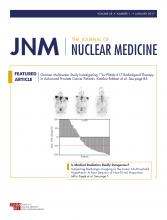Abstract
Anion transport by the human sodium–iodide symporter (hNIS) is an established target for molecular imaging and radionuclide therapy. Current radiotracers for PET of hNIS expression are limited to 124I− and 18F-BF4−. We sought new 18F-labeled hNIS substrates offering higher specific activity, higher affinity, and simpler radiochemical synthesis than 18F-BF4−. Methods: The ability of a range of anions, some containing fluorine, to block 99mTcO4− uptake in hNIS-expressing cells was measured. SO3F− emerged as a promising candidate. 18F-SO3F− was synthesized by reaction of 18F− with SO3–pyridine complex in MeCN and purified using alumina and quaternary methyl ammonium solid-phase extraction cartridges. Chemical and radiochemical purity and serum stability were determined by radiochromatography. Radiotracer uptake and efflux in hNIS-transduced HCT116-C19 cells and the hNIS-negative parent cell line were evaluated in vitro in the presence and absence of a known competitive inhibitor (NaClO4). PET/CT imaging and ex vivo biodistribution measurement were conducted on BALB/c mice, with and without NaClO4 inhibition. Results: Fluorosulfate was identified as a potent inhibitor of 99mTcO4− uptake via hNIS in vitro (half-maximal inhibitory concentration, 0.55–0.56 μM (in comparison with 0.29–4.5 μM for BF4−, 0.07 μM for TcO4−, and 2.7–4.7 μM for I−). Radiolabeling to produce 18F-SO3F− was simple and afforded high radiochemical purity suitable for biologic evaluation (radiochemical purity > 95%, decay-corrected radiochemical yield = 31.6%, specific activity ≥ 48.5 GBq/μmol). Specific, blockable hNIS-mediated uptake in HCT116-C19 cells was observed in vitro, and PET/CT imaging of normal mice showed uptake in thyroid, salivary glands (percentage injected dose/g at 30 min, 563 ± 140 and 32 ± 9, respectively), and stomach (percentage injected dose/g at 90 min, 68 ± 21). Conclusion: Fluorosulfate is a high-affinity hNIS substrate. 18F-SO3F− is easily synthesized in high yield and very high specific activity and is a promising candidate for preclinical and clinical PET imaging of hNIS expression and thyroid-related disease; it is the first example of in vivo PET imaging with a tracer containing an S–18F bond.
Footnotes
Published online Aug. 18, 2016.
- © 2017 by the Society of Nuclear Medicine and Molecular Imaging.







